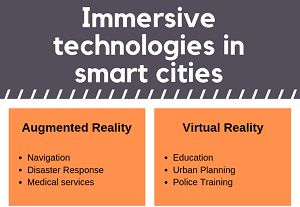 Friday, April 26, 2024
Friday, April 26, 2024  Friday, April 26, 2024
Friday, April 26, 2024 
As blogged on Forbes.com, for quite a while now, there’s been great interest in smart cities. While there is no universally accepted definition of a smart city, the ultimate aim is to provide improved citizen services and a better lifestyle to urban dwellers.
In the quest to transform this ambitious plan into reality, governments, urban planners, engineers, and architects are collaboratively strategizing and leveraging new-age, digital technologies. Big data, AI, IoT, and cloud are a few of the technologies that can contribute to make this initiative a success. While these technological tools help in accomplishing smart city success, augmented reality and virtual reality in smart cities can improve residents’ self-reliance and decision-making. Immersive technologies that either immerse users into an altogether different, interactive and digital environment, or superimpose digital content into a physical world, have unique and compelling uses in smart cities, like the ones discussed below:
Augmented reality in smart cities
With the availability of high-speed, consistent network connectivity, AR technology has matured enough to impact cities in becoming smart, digital, and connected in the following ways:

Navigation
Navigation apps are one of the most important tools for commuters in urban cities. These apps recommend the shortest routes, helping people to easily commute from one location to another in less time. However, AR promises to offer an even more compelling and unique experience for those in need of navigation help.